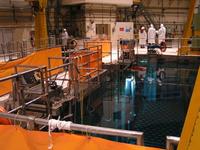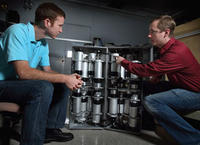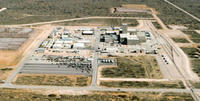-
Scientists develop accident-tolerant nuclear fuels
The summer of 2014 marked an important milestone toward further innovation in the nation’s nuclear plants regarding the development of light water reactor nuclear fuel with enhanced accident tolerant characteristics. For several years, nuclear researchers have designed, fabricated and tested a host of novel nuclear fuels and fuel cladding materials (enclosed tubes that house the fuel in a reactor) in laboratories across the U.S. Now, testing of promising fuels and materials with enhanced accident tolerant characteristics in a U.S. nuclear test reactor is commencing. Scientists and engineers from research labs and industry have prepared advanced concepts for insertion into Idaho National Laboratory’s Advanced Test Reactor.
-
-
Russian secret agents implicated in nuclear poisoning of a critic of Putin
Alexander Litvinenko, a Russian dissident and a vocal critic of President Vladimir Putin, died in London on 23 November 2006 after suffering from radioactive polonium-210 poisoning. An inquest has established that on 1 November 2006 he ingested large quantities of the radioactive material, surreptitiously put in his tea by two agents of the Russian Federal Protective Services. A nuclear expert testifying at the inquest said that less than a millionth of a gram of polonium would be enough to kill a human being.
-
-
U.S.-Russian nuclear security cooperation victim of growing bilateral tensions

One of the greatest benefits brought about by the end of the cold war was the agreement been the United States and the former Soviet republics to cooperate closely in securing the large, and not-always-well-protected, Soviet nuclear stocks. The 1991 Cooperative Threat Reduction agreement, aka the Nunn-Lugar program after the two former senators — Sam Nunn [D-Georgia] and Richard Lugar [R-Indiana]) — who persuaded fellow lawmakers to fund it, has facilitated to achievement of important security measures: dismantling of thousands of nuclear warheads, securing facilities in Russia where weapon-grade material is stored, and finding suitable jobs for tens of thousands of Russian nuclear scientists, engineers, and technicians. More than two decades of cooperation in guarding weapons-grade stockpiles have now come to an end, the result of tensions over Russia’s role in Ukraine. Experts say the end of U.S.-Russia nuclear cooperation leaves the world “a more dangerous place.”
-
-
Realistic radiation detection training without using radioactive materials
Training of first responders on the hazards of actual radiological and nuclear threats has been challenged by the difficulties of adequately representing those threats. Training against such threats would involve using hazardous, highly radioactive materials, experiencing actual radiation doses in training, or require the distribution of radioactive material over a large geographical area. To avoid these issues in exercises to train responders, surrogate radioactive materials have been used, but these materials do not completely represent real threats due to their non-hazardous size and inability to be geographically distributed. Researchers have solved the problem by developing a new technology that provides realistic radiation detection training by directly injecting simulated radiation signals into the analog amplifier of the real detectors used by first responders and inspectors.
-
-
Studying cancer risks near nuclear facilities
The National Academy of Sciences has issues a brief report which provides an expert committee’s advice about general methodological considerations for carrying out a pilot study of cancer risks near seven nuclear facilities in the United States. The pilot study will assess the feasibility of two approaches that could be used in a nationwide study to analyze cancer risk near nuclear facilities regulated by the U.S. Nuclear Regulatory Commission (NRC).
-
-
If South Korea’s nuclear plant staff are vulnerable, then so are the reactors
Does it matter that a South Korean nuclear plant was hacked and plans of the complex stolen? As it is South Korea that’s the subject of this latest attack, everyone tends to assume it must have had something to do with North Korea. With a target as sensitive as a nuclear power plant, not unreasonably people are asking if safety could be compromised by a cyberattack. Could hackers cause the next Chernobyl or Three Mile Island? This points to an important and infrequently discussed problem, the vulnerability of critical national infrastructure. Cyber-attacks like these are a great way of levelling the playing field: why invest in massively expensive nuclear weapons program if you can simply shut down your enemies’ power, gas, water, and transportation systems? Increasingly more and more infrastructure is connected to the Internet, with all the security risks that entails.
-
-
One million curies of radioactive material safely recovered
Experts at the Los Alamos National Laboratory (LANL) helped the Department of Energy’s (DOE) Off-Site Source Recovery Project (OSRP) recover more than one million curies of radioactive sources since 1999. LANL says that the accomplishment represents a major milestone in protecting our nation and the world from material that could be used in “dirty bombs” by terrorists. “Taking disused, unwanted and, in limited cases, abandoned nuclear materials out of harm’s reach supports the Laboratory’s mission of reducing global nuclear danger,” said Terry Wallace, principal associate director for global security at Los Alamos.
-
-
Industry: Multiple redundant and back-up systems make nuclear plants safer than ever
Nuclear plants receive what supporters of nuclear power regard as an unfair amount of scrutiny and concern for their safety, but industry experts say that plant equipment and plant operations are highly regulated to minimize risks.All U.S. nuclear plants are now storing emergency pumps, generators, battery banks, chargers, compressors, and hoses at off-site locations near the plants to protect against floods, industry insiders say.Working in a nuclear plant is much safer than working in a paper mill or a chemical plant, according to Jim Krafty, a Nuclear Regulatory Commission (NRC) resident senior inspector at the Beaver Valley nuclear power plant in Shippingport, Pennsylvania.
-
-
U.S. Army seeking to end environmental testing at Indiana nuclear firing range
The U.S. Army wants to end its Nuclear Regulatory Commission (NRC) license at the Jefferson Proving Ground in southern Indiana. The Army’s appeal comes after years of water and soil testing at the site. Currently, an estimated 162,040 pounds of depleted uranium projectiles and shows are still on the firing range. The site was last used in 1995. Uranium munitions, specifically the kind used to penetrate armor during Operation Desert Shield, were used there throughout the 1980s and 1990s.
-
-
Improving nuclear power plant safety by looking at nature
Within the nuclear industry, hazardous salt solutions can arise within industrial containment vessels. The salt solution precipitates out, forming structures with strange morphologies that bear a resemblance to stalagmites. If left unchecked, they could build up and cause a problem in the nuclear containment chamber. Currently, these containment chambers are checked regularly to prevent this from happening. Taking inspiration from nature, researchers have created a versatile model to predict how stalagmite-like structures form in nuclear processing plants — as well as how lime scale builds up in kettles.
-
-
Risks of terrorists attacking, or using materials from, a nuclear power plant are low: Experts

Energy analysts who support new nuclear power plants construction insist that the probability of a terrorist nuclear attack by land, sea, or air is extremely low. They reject arguments by nuclear power opponents that terrorist groups may one day attack a nuclear plant, or build an improvised nuclear bomb using materials stolen from a nuclear power plant – and that governments should, therefore, end construction of new nuclear power plants. Climate scientists supporting reduction in CO2 emissions wrote that “There is no credible path to climate stabilization that does not include a substantial role for nuclear power.”
-
-
Washington State supports new Hanford project, but worries about cost
The state of Washington is supporting a new facility which would lessen the load on the Hanford vitrification (vit) plant to process nuclear waste, but has expressed concerns about how the U.S. Department of Energy (DOE) will pay for the project. Only rough estimates of the cost of the project – called LAWPS, or the Low-Activity Waste Pretreatment System — have been made, but these estimates run between $243 million and $375 million, though that number does not include infrastructure costs such as the addition of roadways and utility services.
-
-
New light shed on reactor fuel behavior during severe nuclear reactor accidents
UO2 is the primary fuel component in the majority of existing nuclear reactors, but little is known about the molten state because of its extremely high melting point. Until now, the extremely high temperature and chemical reactivity of the melt have hindered studies of molten UO2. This lack of fundamental information has made it difficult to evaluate issues associated with the interaction of molten UO2 with a reactor’s zirconium cladding and steel containment vessel. A new discovery about the atomic structure of uranium dioxide will help scientists select the best computational model to simulate severe nuclear reactor accidents.
-
-
Sandia Lab’s mobile neutron imager shines in urban emergency response exercise

A nuclear device has been hidden in a high-rise building in a major metropolitan area. Emergency responders have intelligence that narrows down the location to a single city block, but it is not safe to search door-to-door. Can they identify the exact location of the device quickly without the culprits realizing a search is on? The answer is a definite yes. Sandia Lab’ mobile imager of neutrons for emergency responders (MINER) system did just that at an emergency response exercise in downtown Chicago earlier this year. The exercise used a sealed laboratory radiation source that mimics the radioactive signature of more nefarious material.
-
-
U.S. planning expansion of nuclear production in the face of safety concerns

Despite the release of a damning report regarding the 14 February nuclear waste accident at the Waste Isolation Pilot Plant (WIPP) near Carlsbad, New Mexico by the U.S. Department of Energy (DOE), the government is planning ramped-up production of nuclear weapons cores, a move which is raising red flags for those calling for reform of nuclear production and storage procedures.
-
More headlines
The long view
Keeping the Lights on with Nuclear Waste: Radiochemistry Transforms Nuclear Waste into Strategic Materials
How UNLV radiochemistry is pioneering the future of energy in the Southwest by salvaging strategic materials from nuclear dumps –and making it safe.
Model Predicts Long-Term Effects of Nuclear Waste on Underground Disposal Systems
The simulations matched results from an underground lab experiment in Switzerland, suggesting modeling could be used to validate the safety of nuclear disposal sites.
